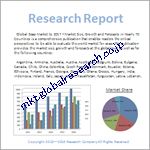目次
第1章.クラウド統合ソフトウェアの世界市場 エグゼクティブサマリー
1.1.クラウド統合ソフトウェアの世界市場規模・予測(2022年~2032年)
1.2.地域別概要
1.3.セグメント別概要
1.3.1.展開別
– クラウドベース
– オンプレミス
– ハイブリッド
1.3.2.データソース別
– クラウドアプリケーション
– オンプレミス・アプリケーション
– IoTデバイス
1.3.3.統合タイプ別
– データ統合
– アプリケーション統合
– プロセス統合
1.3.4.業種別
– 金融サービス
– ヘルスケア
– 製造業
– 小売
1.3.5.組織規模別
– 中小企業(SMEs)
– 大企業
1.4.主要動向
1.5.不況の影響
1.6.アナリストの提言と結論
第2章 クラウド統合ソフトウェアの世界市場世界のクラウド統合ソフトウェア市場の定義と調査前提
2.1.調査目的
2.2.市場の定義
2.3.調査の前提
2.3.1.包含と除外
2.3.2.限界
2.3.3.供給サイドの分析
2.3.3.1.入手可能性
2.3.3.2.インフラ
2.3.3.3.規制環境
2.3.3.4.市場競争
2.3.3.5.経済性(消費者の視点)
2.3.4.需要サイド分析
2.3.4.1.規制の枠組み
2.3.4.2.技術の進歩
2.3.4.3.環境への配慮
2.3.4.4.消費者の意識と受容
2.4.推定方法
2.5.調査対象年
2.6.通貨換算レート
第3章.クラウド統合ソフトウェアの世界市場ダイナミクス
3.1.市場促進要因
3.1.1.クラウド導入とデジタルトランスフォーメーションの急増
3.1.2.IoTデバイスとデータストリームの急激な成長
3.1.3.リアルタイム分析と拡張性の需要
3.2.市場の課題
3.2.1.初期導入コストの高さと統合の複雑さ
3.2.2.データ・プライバシーとセキュリティへの懸念
3.3.市場機会
3.3.1.AIを活用した統合ツールの進歩
3.3.2.ローコード/ノーコード・プラットフォームの出現
3.3.3.戦略的コラボレーションとM&A
第4章 クラウド統合ソフトウェアの世界市場クラウド統合ソフトウェアの世界市場産業分析
4.1.ポーターの5フォースモデル
4.1.1.サプライヤーの交渉力
4.1.2.バイヤーの交渉力
4.1.3.新規参入者の脅威
4.1.4.代替品の脅威
4.1.5.競合他社との競争
4.1.6.ポーターの5フォースモデルへの未来的アプローチ
4.1.7.ポーター5フォースのインパクト分析
4.2.PESTEL分析
4.2.1.政治的
4.2.2.経済的
4.2.3.社会的
4.2.4.技術的
4.2.5.環境
4.2.6.法律
4.3.主な投資機会
4.4.トップ勝ち組戦略
4.5.破壊的トレンド
4.6.業界専門家の視点
4.7.アナリストの推奨と結論
第5章 クラウド統合ソフトウェアの世界市場クラウド統合ソフトウェアの世界市場規模推移と展開別予測(2022年~2032年)
5.1.セグメントダッシュボード
5.2.クラウド統合ソフトウェアの世界市場デプロイメント別売上動向分析、2022年および2032年(百万米ドル/億ドル)
5.2.1.クラウドベース
5.2.2.オンプレミス
5.2.3.ハイブリッド
第6章 クラウド統合ソフトウェアの世界市場クラウド統合ソフトウェアの世界市場規模・予測:データソース別、統合タイプ別、業種別、組織規模別(2022〜2032年)
6.1.セグメントダッシュボード
6.2.クラウド統合ソフトウェアの世界市場収益動向分析、2022年および2032年 (百万米ドル/億米ドル)
6.2.1.データソース
– クラウドアプリケーション
– オンプレミスアプリケーション
– IoTデバイス
6.2.2.統合タイプ
– データ統合
– アプリケーション統合
– プロセス統合
6.2.3.業種別
– 金融サービス
– ヘルスケア
– 製造業
– 小売
6.2.4.組織規模
– 中小企業(SMEs)
– 大企業
第7章 クラウド統合ソフトウェアの世界市場クラウド統合ソフトウェアの世界地域別市場規模・予測(2022~2032年)
7.1.北米
7.1.1.米国
7.1.2.カナダ
7.2.ヨーロッパ
7.2.1.英国
7.2.2.ドイツ
7.2.3.フランス
7.2.4.スペイン
7.2.5.イタリア
7.2.6.その他のヨーロッパ(ROE)
7.3.アジア太平洋
7.3.1.中国
7.3.2.インド
7.3.3.日本
7.3.4.オーストラリア
7.3.5.韓国
7.3.6.その他のアジア太平洋地域(RoAPAC)
7.4.ラテンアメリカ
7.4.1.ブラジル
7.4.2.メキシコ
7.5.中東・アフリカ
7.5.1.サウジアラビア
7.5.2.南アフリカ
7.5.3.その他の中東・アフリカ地域(RoMEA)
第8章.コンペティティブ・インテリジェンス
8.1.主要企業のSWOT分析
8.1.1.IBMコーポレーション
8.1.2.マイクロソフト株式会社
8.1.3.オラクル
8.2.トップ市場戦略
8.3.企業プロフィール
8.3.1.IBMコーポレーション
8.3.1.1.主要情報
8.3.1.2.概要
8.3.1.3.財務(データの入手可能性による)
8.3.1.4.製品概要
8.3.1.5.市場戦略
8.3.2.マイクロソフト株式会社
8.3.3.オラクル
8.3.4.SAP SE
8.3.5.デル・テクノロジーズ
8.3.6.セールスフォース
8.3.7.インフォマティカ・エルエルシー
8.3.8.MuleSoft LLC (A Salesforce Company)
8.3.9.Boomi (デル・テクノロジーズのビジネス)
8.3.10.Workato Inc.
8.3.11.株式会社ジッタービット
8.3.12.スナップロジック
8.3.13.Tibco Software Inc.
8.3.14.ソフトウェアAG
8.3.15.富士通株式会社
第9章.研究プロセス
9.1.研究プロセス
9.1.1.データマイニング
9.1.2.分析
9.1.3.市場推定
9.1.4.バリデーション
9.1.5.出版
9.2.研究属性
表一覧
表1.クラウド統合ソフトウェアの世界市場、レポートスコープ
表2.クラウド統合ソフトウェアの世界市場:地域別2022年~2032年予測(百万米ドル/億米ドル)
表3.クラウド統合ソフトウェアの世界市場:2022年~2032年展開別予測・金額(百万ドル/億ドル)
表4.クラウド統合ソフトウェアの世界市場 2022-2032年 データソース別 推計・予測 (百万ドル/億ドル)
表5.クラウド統合ソフトウェアの世界市場:統合タイプ別見積もりと予測 2022-2032 (百万米ドル/億ドル)
表6.クラウド統合ソフトウェアの世界市場:産業分野別2022年~2032年予測・予測(百万ドル/億ドル)
表7.クラウド統合ソフトウェアの世界市場:組織規模別2022年~2032年予測・予測(USD Million/Billion)
表8.クラウド統合ソフトウェアの世界市場:セグメント別推計・予測 2022-2032 (百万米ドル/億ドル)
表9.クラウド統合ソフトウェアの世界市場:地域別、見積もりおよび予測、2022年~2032年(百万米ドル/億米ドル)
表10.米国のクラウド統合ソフトウェア市場予測:2022-2032年(百万米ドル/億ドル)
表11.米国のクラウド統合ソフトウェア市場のセグメント別見積もりと予測、2022~2032年 (百万米ドル/億ドル)
表12.カナダのクラウド統合ソフトウェア市場予測:2022-2032年(百万米ドル/億ドル)
表13.カナダのクラウド統合ソフトウェア市場のセグメント別見積もりと予測、2022~2032年 (百万米ドル/億ドル)
表14.欧州クラウド統合ソフトウェア市場 2022-2032年予測 (百万ドル/億ドル)
表15.欧州クラウド統合ソフトウェア市場セグメント別見積もりと予測、2022-2032年 (百万米ドル/億ドル)
表16.アジア太平洋地域クラウド統合ソフトウェア市場予測:2022-2032年(百万ドル/億ドル)
表17.アジア太平洋地域のクラウド統合ソフトウェア市場のセグメント別見積もりと予測、2022年~2032年(百万米ドル/億米ドル)
表18.ラテンアメリカのクラウド統合ソフトウェア市場の見積もりと予測、2022年~2032年(百万米ドル/億ドル)
表 19.ラテンアメリカのクラウド統合ソフトウェア市場セグメント別見積もりと予測、2022年~2032年(百万米ドル/億米ドル)
表 20.中東・アフリカ クラウド統合ソフトウェア市場 2022年~2032年予測 (百万ドル/億ドル)
表21.中東・アフリカクラウド統合ソフトウェア市場セグメント別見積もりと予測、2022年~2032年(百万米ドル/億米ドル)
図表一覧
図1.クラウド統合ソフトウェアの世界市場、調査手法
図2.クラウド統合ソフトウェアの世界市場、市場推定手法
図3.クラウド統合ソフトウェアの世界市場、主要動向2023年
図4 クラウド統合ソフトウェアの世界市場クラウド統合ソフトウェアの世界市場、成長見通し2022年~2032年
図5 クラウド統合ソフトウェアの世界市場クラウド統合ソフトウェアの世界市場、ポーターの5フォースモデル
図6. クラウド統合ソフトウェアの世界市場、PESTEL分析
図7.クラウド統合ソフトウェアの世界市場、バリューチェーン分析
図8.クラウド統合ソフトウェアの世界市場:展開別、2022年・2032年(百万ドル/億ドル)
図9. クラウド統合ソフトウェアの世界市場:データソース別、2022年および2032年(百万ドル/億ドル)
図10.クラウド統合ソフトウェアの世界市場:統合タイプ別、2022年・2032年(百万ドル/億ドル)
図11.クラウド統合ソフトウェアの世界市場:産業分野別、2022年~2032年(百万ドル/億ドル)
図12.クラウド統合ソフトウェアの世界市場:組織規模別、2022年・2032年(百万ドル/億ドル)
図13.クラウド統合ソフトウェアの世界市場、地域別スナップショット(2022年&2032年
図14.北米のクラウド統合ソフトウェア市場 2022年~2032年 (百万米ドル/億米ドル)
図15.欧州のクラウド統合ソフトウェア市場 2022 & 2032 (百万米ドル/億米ドル)
図16.アジア太平洋地域のクラウド統合ソフトウェア市場 2022 & 2032 (百万米ドル/億米ドル)
図17.中南米のクラウド統合ソフトウェア市場 2022 & 2032 (百万米ドル/億米ドル)
図18.中東・アフリカのクラウド統合ソフトウェア市場 2022~2032 (百万ドル/億ドル)
図 19.クラウド統合ソフトウェアの世界市場、企業市場シェア分析(2023年)
The market’s expansion is primarily driven by the surging adoption of cloud-based applications across industries, necessitating seamless data flow and real-time analytics. With the exponential growth of IoT devices, enterprises seek robust integration frameworks to manage diverse data streams efficiently. Furthermore, regulatory compliance requirements, especially in financial services and healthcare, are pushing organizations to invest in advanced cloud integration solutions that ensure data security, governance, and interoperability. Notably, key investments in artificial intelligence (AI)-powered integration tools are augmenting automation capabilities, reducing manual workflows, and enhancing decision-making efficiency.
In addition to technological advancements, strategic collaborations and mergers and acquisitions among major market players are accelerating innovation and market penetration. For instance, industry leaders are forming alliances to develop next-generation low-code/no-code integration platforms, empowering enterprises with user-friendly, drag-and-drop functionalities to streamline business processes. However, challenges such as high initial deployment costs, data privacy concerns, and integration complexity across legacy systems pose certain constraints to market growth. Companies are actively addressing these issues by introducing subscription-based, scalable integration solutions that cater to businesses of all sizes, especially SMEs looking for cost-effective digital transformation strategies.
Geographically, North America dominates the market, attributed to its strong IT infrastructure, extensive adoption of cloud-native solutions, and the presence of leading integration service providers. The Asia Pacific region is projected to witness the fastest growth during the forecast period, driven by the rapid digitalization of enterprises, increased government initiatives supporting cloud adoption, and the emergence of dynamic startup ecosystems in countries like China, India, and Japan. Meanwhile, Europe continues to be a key player, benefiting from stringent data protection regulations (GDPR) that drive demand for compliant cloud integration frameworks.
Major market players included in this report are:
• IBM Corporation
• Microsoft Corporation
• Oracle Corporation
• SAP SE
• Dell Technologies Inc.
• Salesforce Inc.
• Informatica LLC
• MuleSoft LLC (A Salesforce Company)
• Boomi (A Dell Technologies Business)
• Workato Inc.
• Jitterbit Inc.
• SnapLogic Inc.
• Tibco Software Inc.
• Software AG
• Fujitsu Ltd.
The detailed segments and sub-segments of the market are explained below:
By Deployment:
• Cloud-Based
• On-Premises
• Hybrid
By Data Source:
• Cloud Applications
• On-Premises Applications
• IoT Devices
By Integration Type:
• Data Integration
• Application Integration
• Process Integration
By Industry Vertical:
• Financial Services
• Healthcare
• Manufacturing
• Retail
By Organization Size:
• Small and Medium-sized Enterprises (SMEs)
• Large Enterprises
By Region:
North America
• U.S.
• Canada
Europe
• UK
• Germany
• France
• Spain
• Italy
• Rest of Europe (ROE)
Asia Pacific
• China
• India
• Japan
• Australia
• South Korea
• Rest of Asia Pacific (RoAPAC)
Latin America
• Brazil
• Mexico
Middle East & Africa
• Saudi Arabia
• South Africa
• Rest of Middle East & Africa (RoMEA)
Years considered for the study:
• Historical Year – 2022
• Base Year – 2023
• Forecast Period – 2024 to 2032
Key Takeaways:
• Market estimates & forecast for 10 years from 2022 to 2032.
• Annualized revenues and regional-level analysis for each market segment.
• Detailed analysis of the geographical landscape with country-level insights.
• Competitive landscape featuring major players in the market.
• In-depth evaluation of key business strategies and recommendations on future market approaches.
• Analysis of the competitive structure of the market.
• Comprehensive demand-side and supply-side analysis of the market.
❖ 免責事項 ❖
http://www.globalresearch.jp/disclaimer

